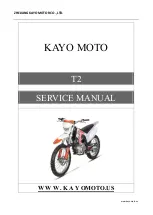
V E N G E A N C E M O T O R C Y C L E S O W N E R S M A N U A L
- 29 -
Vengeance Motorcycles, Mira Loma, CA USA • 866-483-6432 • www.VengeanceMotorcycles.com
© 2003 Vengeance Performance Products, LLC All Rights Reserved • VOM 1st Edition Rev 2.3 06/03
POWERTRAIN
The powertrain of your Vengeance Motorcycle consists of four components:
•
V-Twin, air-cooled, 124, 113 or 107 cubic inch, four-stroke Engine
•
Belt-driven Primary Drive
•
5-speed transmission (or optional 6-speed)
•
Belt-driven Final Drive
The engine is powered by two large cylinders and combustion chambers that are capable of developing incredible
power for a V-Twin four-stroke engine. “Four-stroke” means that each piston moves four times (strokes) for the engine
to complete one full cycle.
1. Intake
Stroke: the piston moves down while the intake valve is open, pulling the air/fuel mixture into
the cylinder.
2. Compression
Stroke: the piston moves upward pressurizing the air/fuel mixture.
3. Power
Stroke: as the spark plug ignites the compressed air/fuel mixture, the combustion pushes the
piston back down.
4. Exhaust
Stroke: with the exhaust valve open the piston moves upward again, pushing the burned
gases out of the cylinder.
At normal operating speeds, the pistons cycle at 3,000 to 5,000 revolutions per minute while the spark plugs fire at
just the right time to maintain the speed and performance demanded by the rider. Your engine's performance is
determined by compression (its ability to seal itself). Breaking in your engine properly is critical in order for the valves,
rings, pistons, and all the other moving components within the engine to "seat' or "wear-in," enabling the combustion
chamber to seal and allow for maximum compression.
NOTE: REFER TO THE “ENGINE BREAK-IN PERIOD” SECTION IN THIS MANUAL FOR SPECIFIC ON
PROPERLY BREAKING IN YOUR ENGINE.
The power generated by the engine is transmitted to the rear tire through a combination of belts, gears and sprockets
shared by the primary drive, transmission, clutch, and final drive.
The primary drive delivers power from the engine to the transmission and is composed of a primary drive belt which
runs from the engine crankshaft to the clutch in the transmission.
Various size gears in the transmission provide a wide range of rear wheel speeds, while permitting the engine to
operate within its range of normal operating speeds. Smaller gears provide more torque while larger gears provide
















































